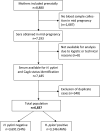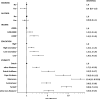Ethnicity is a strong predictor for Helicobacter pylori infection in young women in a multi-ethnic European city
- PMID: 23808840
- PMCID: PMC3822168
- DOI: 10.1111/jgh.12315
Ethnicity is a strong predictor for Helicobacter pylori infection in young women in a multi-ethnic European city
Abstract
Background and aim: At the same time that Helicobacter pylori prevalence is declining in Western countries, immigrants from developing countries with high H. pylori prevalence have settled in Western urban areas. Actual epidemiological data on H. pylori in a migrant community may help in realizing a more selective approach to assess H. pylori-related diseases. We aimed to define H. pylori prevalence as well as risk groups for H. pylori in a cohort of young women living in a multi-ethnic European city.
Methods: We measured Immunoglobulin G (IgG) anti-H. pylori and CagA-antibodies in serum of pregnant women included in a population-based prospective cohort study, the Generation R study. Information on demographics and socioeconomic status was collected by questionnaires. Chi-square and logistic regression were used.
Results: In total, 3146 (46%) of the 6837 tested women (mean age 29.7 ± 5.3) were H. pylori-positive and 1110 (35%) of them were CagA-positive. The H. pylori prevalence in Dutch women was 24%, which was significantly lower than in non-Dutch women (64%; P < 0.001). In particular, H. pylori positivity was found in 92% of Moroccan (odds ratio 19.2; 95% confidence interval 11.8-32.0), 80% of Cape Verdean (7.6; 5.0-11.5), 81% of Turkish (9.0; 6.7-12.1), 60% of Dutch Antillean (3.3; 2.3-4.7), and 58% of Surinamese women (3.0; 2.3-3.8). Among H. pylori-positive Dutch subjects, 19% were CagA-positive compared with 40% of the non-Dutch subjects (P < 0.001).
Conclusions: Despite a general trend of declining prevalence in Western countries, H. pylori remains highly prevalent in migrant communities, which may constitute target groups for screening and eradication to prevent H. pylori-related diseases.
Keywords: CagA protein; Helicobacter pylori; epidemiology.
© 2013 Journal of Gastroenterology and Hepatology Foundation and Wiley Publishing Asia Pty Ltd.
Figures
Similar articles
-
Migrant communities constitute a possible target population for primary prevention of Helicobacter pylori-related complications in low incidence countries.Scand J Gastroenterol. 2008;43(4):403-9. doi: 10.1080/00365520701814077. Scand J Gastroenterol. 2008. PMID: 18365904
-
Explaining ethnic differences in late antenatal care entry by predisposing, enabling and need factors in The Netherlands. The Generation R Study.Matern Child Health J. 2011 Aug;15(6):689-99. doi: 10.1007/s10995-010-0619-2. Matern Child Health J. 2011. PMID: 20533083 Free PMC article.
-
Intergenerational reduction in Helicobacter pylori prevalence is similar between different ethnic groups living in a Western city.Gut. 2015 Aug;64(8):1200-8. doi: 10.1136/gutjnl-2014-307689. Epub 2014 Aug 28. Gut. 2015. PMID: 25192563 Free PMC article.
-
Epidemiology of Helicobacter pylori infection.Helicobacter. 2014 Sep;19 Suppl 1:1-5. doi: 10.1111/hel.12165. Helicobacter. 2014. PMID: 25167938 Review.
-
Review article: the prevalence of Helicobacter pylori and the incidence of gastric cancer across Europe.Aliment Pharmacol Ther. 2016 Feb;43(3):334-45. doi: 10.1111/apt.13474. Epub 2015 Nov 23. Aliment Pharmacol Ther. 2016. PMID: 26592801 Review.
Cited by
-
South Asian Health: Inflammation, Infection, Exposure, and the Human Microbiome.J Immigr Minor Health. 2019 Aug;21(Suppl 1):26-36. doi: 10.1007/s10903-017-0652-y. J Immigr Minor Health. 2019. PMID: 28952002 Free PMC article. Review.
-
Helicobacter pylori in children with asthmatic conditions at school age, and their mothers.Aliment Pharmacol Ther. 2016 Apr;43(8):933-943. doi: 10.1111/apt.13572. Epub 2016 Mar 1. Aliment Pharmacol Ther. 2016. PMID: 26932510 Free PMC article.
-
Correlates of infection with Helicobacter pylori positive and negative cytotoxin-associated gene A phenotypes among Arab and Jewish residents of Jerusalem.Epidemiol Infect. 2019 Sep 25;147:e276. doi: 10.1017/S0950268819001456. Epidemiol Infect. 2019. PMID: 31552815 Free PMC article.
-
Risk factors of Helicobacter pylori infection in Bukavu, Democratic Republic of the Congo: a case-control study.Ann Med Surg (Lond). 2023 Mar 25;85(4):727-731. doi: 10.1097/MS9.0000000000000409. eCollection 2023 Apr. Ann Med Surg (Lond). 2023. PMID: 37113886 Free PMC article.
-
Helicobacter pylori seropositivity associates with hyperglycemia, but not obesity, in Danish children and adolescents.BMC Med. 2024 Sep 11;22(1):379. doi: 10.1186/s12916-024-03591-w. BMC Med. 2024. PMID: 39256870 Free PMC article.
References
-
- Post PN, Kuipers EJ, Meijer GA. Declining incidence of peptic ulcer but not of its complications: a nation-wide study in The Netherlands. Aliment Pharmacol Ther. 2006;23:1587–93. - PubMed
Publication types
MeSH terms
Grants and funding
LinkOut - more resources
Full Text Sources
Other Literature Sources
Medical




